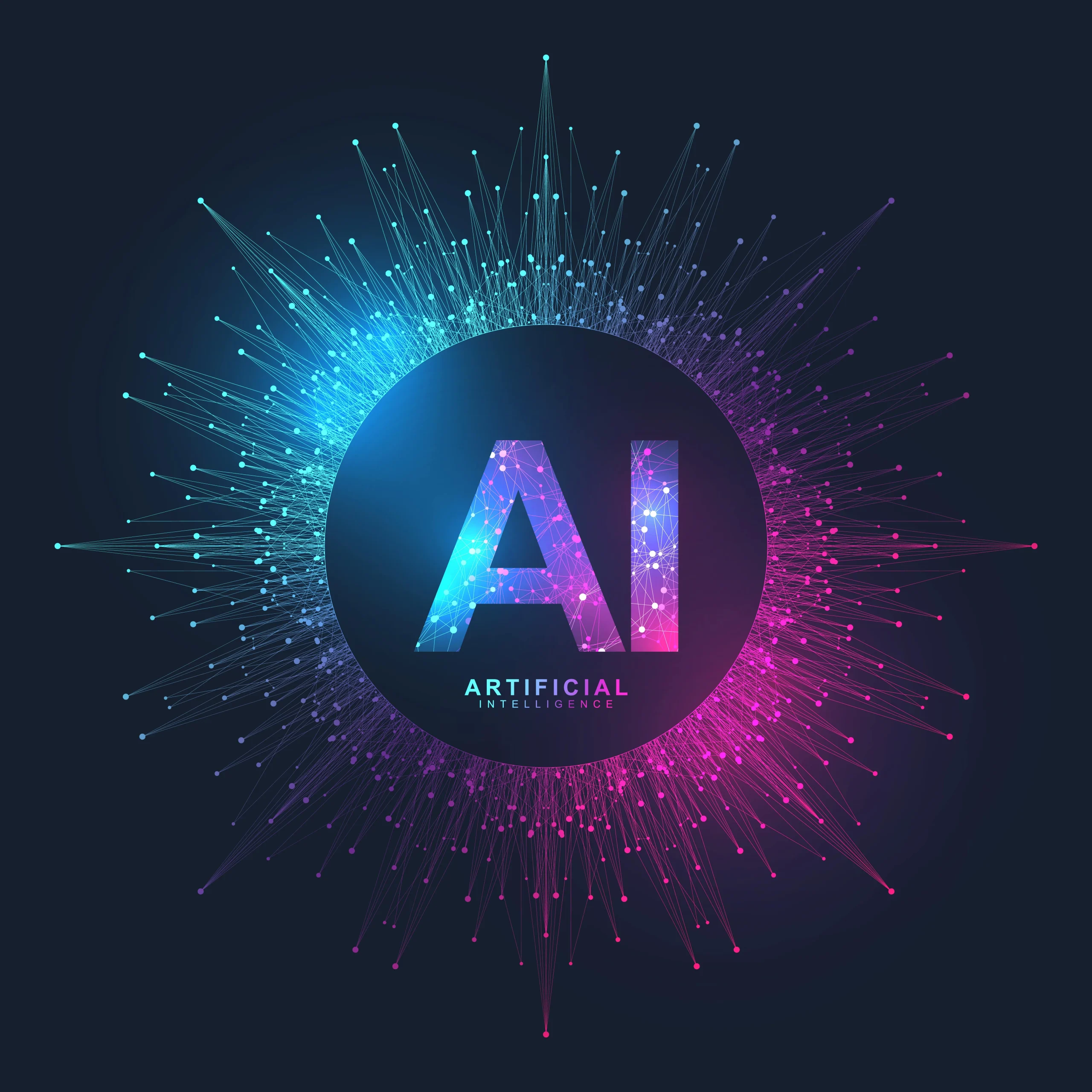Top 10 AI Trends in 2025
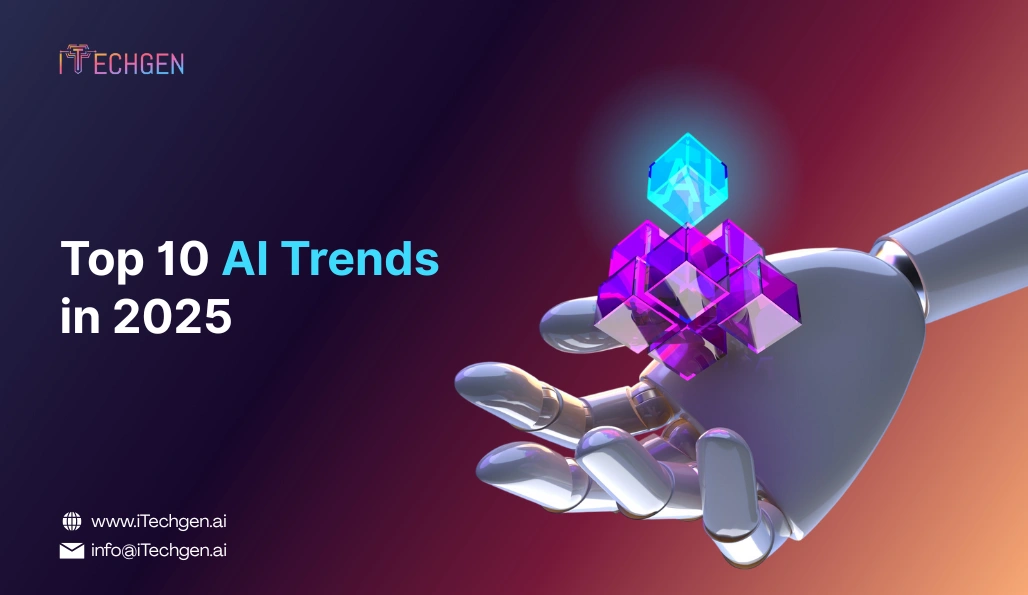
2025 is already turning out to be a landmark year for artificial intelligence. But what exactly are the top AI trends 2025 shaping this shift? It’s no longer just about chatbots or robots doing factory work. AI is quietly becoming a part of how we live, work, learn, and even make decisions. From apps that talk like humans to tools that predict your next move online, the changes are big — and fast. What used to feel like sci-fi is now everyday tech, and most of us are using it without even realizing.
The top AI trends of 2025 are not just technical upgrades. They’re a clear sign that industries are moving from trial mode to full-scale adoption. Whether it’s healthcare, education, finance, or media — everyone is trying to use AI to save time, improve accuracy, or offer better services. Businesses are investing in smarter workflows, while users are seeing AI in their daily experiences — like better movie recommendations or quicker support chats. In this blog, we break down these trends in simple words, without tech jargon, so you get a clear idea of what’s happening.
Another reason to follow the top AI trends in 2025 is because they affect real jobs, businesses, and the way people interact online. AI is now designing logos, writing emails, fixing customer queries, and even helping doctors with diagnoses. These aren’t far-off ideas — they are already here. If you’re a startup owner, developer, or just someone curious about what’s coming next, knowing these trends helps you plan smarter and stay ahead. This blog is your easy guide to understanding all of it — without complicated terms or confusing buzzwords. so, let’s get started:
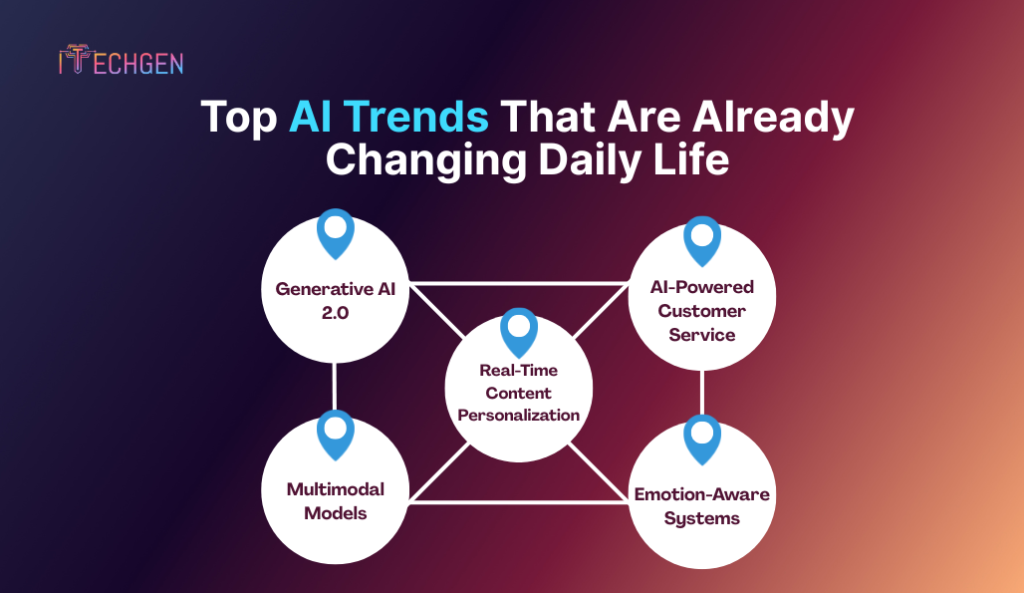
1. Generative AI 2.0
Generative AI is no longer limited to basic text tools or image generators. In 2025, it has evolved into a more powerful and flexible system — one that supports creativity across industries. This new wave is helping people write scripts, compose music, design logos, and even build websites without needing expert-level skills. What’s different now? These tools are not just smarter, they’re becoming easier for everyday users to access. That’s why this category tops the list in the top AI trends 2025.
Why It Matters:
- Saves time and cost for creators, marketers, and businesses
- Makes creative tools accessible even without technical skills
- Boosts productivity by automating design, writing, and editing tasks
- Widely used in industries like advertising, education, and eCommerce
- Shifts focus from technical know-how to pure creativity
Multimodal Models (Text, Video, Audio)
Multimodal AI can handle different types of inputs at the same time — like voice, images, text, and video. So instead of switching between tools, users can now create or search across formats in one go. This means you can describe a video using a voice note or generate an image by typing a prompt. From making lesson plans to building reels, these models are saving creators hours of manual work and offering better, faster outputs — all through one platform.
Real-Time Content Personalization
This trend is transforming how content is delivered online. AI now tracks your behavior live and adjusts content while you’re still on the platform. Whether it’s changing product listings, video feeds, or homepages — the system reacts in real-time. So, if you pause on a jacket for more than a few seconds, the site may instantly suggest matching shoes or show reviews. This makes user journeys smoother and boosts conversions for brands — making it one of the most business-friendly top AI trends 2025.
Democratized Creative Tools
In 2025, tools like AI video makers, AI logo designers, and AI music composers have become common — and affordable. What used to need an entire design team can now be done from a smartphone. Small businesses, students, influencers — everyone is using these tools to produce polished, professional content in minutes. This shift is helping users save money on outsourcing and launch ideas faster. That’s why democratized tools are now leading the change in digital creativity across industries worldwide.
Case study of real life usage of Generative AI in 2025:
In 2025, generative AI moved from hype to hands-on usage across industries. It wasn’t just about chatbots or art — real businesses started solving real problems. For example, Domino’s in North America used lifelike AI-generated voices to improve phone orders, speeding up service without sounding robotic. At the same time, fashion brands like Victoria’s Secret used AI to personalize emails in real time, increasing customer clicks and conversions. Platforms like Canva made pro-level design tools available to everyday users, cutting design costs for startups. These are not future promises — they’re live use cases already reshaping how work gets done worldwide.
| Trend | Real-World Example (2025) | Source |
| 1. Multimodal AI (Text, Video, Audio) | Domino’s Pizza in North America enhanced its phone ordering system using AI-generated voices that sound natural and region-specific, improving customer interactions. | Business Insider |
| 2. Real-Time Content Personalization | Victoria’s Secret utilized AI to craft personalized email campaigns, leading to increased customer engagement and sales. | Vogue Business |
| 3. Democratized Creative Tools | Canva empowered over 100 million users globally to design graphics effortlessly, making professional design accessible to non-designers. | Medium |
| 4. Self-Learning Workflows | Citi integrated AI across its operations to automate document processing and enhance customer service efficiency. | Google Cloud |
| 5. Enterprise Task Automation | UPS implemented agentic AI to optimize logistics, improving delivery routes and operational efficiency. | CDO Times |
| 6. Ethical Safeguards | The New York Times entered a licensing agreement with Amazon to ensure its content is used responsibly in AI training, setting a precedent for ethical AI use. | Financial Times |
| 7. Accelerated Drug Discovery | Latent Labs, founded by a former DeepMind scientist, used AI to design synthetic proteins, expediting the drug discovery process. | Financial Times |
| 8. Climate & Sustainability Modeling | Greyparrot developed an AI system to analyze waste processing, enhancing recycling efficiency and reducing environmental impact. | World Economic Forum |
| 9. Quantum Computing Integration | Wipro’s innovation labs focused on integrating quantum computing with AI, attracting Gen Z and Gen Alpha professionals to work on cutting-edge projects. | Times of India |
| 10. Brain-Computer Interfaces (BCIs) | MIT researchers developed AI models that learn to associate sounds with visual events without human intervention, advancing the field of BCIs. | MIT News |
2. Autonomous AI Agents
One of the most talked-about top AI trends in 2025 is the rise of AI agents that can work on their own — without needing step-by-step instructions. These are not simple bots. They’re full-fledged systems that understand tasks, plan the steps, adjust in real-time, and even learn from past mistakes. Think of them as virtual team members who can book meetings, sort emails, write reports, or even manage customer support — all without constant supervision. They’re saving hours of work for startups, creators, and businesses alike.
Why It Matters:
- Cuts down manual, repetitive work like emails, scheduling, and data entry
- Useful for both small teams and large businesses
- Reduces human errors in routine operations
- Learns from feedback to improve over time
- Allows employees to focus more on strategy than execution
Self-Learning Workflows
AI agents now go beyond fixed commands. They can figure out how to solve a task by learning from examples or past results. For instance, a support chatbot might notice that users are asking similar questions in different ways. It adapts without needing a developer to reprogram it. These self-learning workflows are helping reduce the time and cost spent on managing backend operations, especially in sectors like tech support, HR, and admin.
Enterprise Task Automation
In large companies, many day-to-day tasks are repetitive — like approving documents, checking invoices, or updating databases. AI agents are now handling these processes independently. This frees up the workforce to handle complex issues instead of chasing routine checklists. In many traditional office settings, where documentation and approvals can be slow, this automation is cutting down weeks of delay into hours.
Ethical Safeguards
With more automation, there’s also more responsibility. One of the key top AI trends 2025 now is adding checks and balances into these agents. That means AI won’t just act blindly — it checks if actions follow ethical rules or user privacy laws. For example, if an AI tool is analyzing user data, it now flags risky behaviour or stops itself from going beyond limits. This is important for industries like healthcare, banking, and education where trust and safety are key.
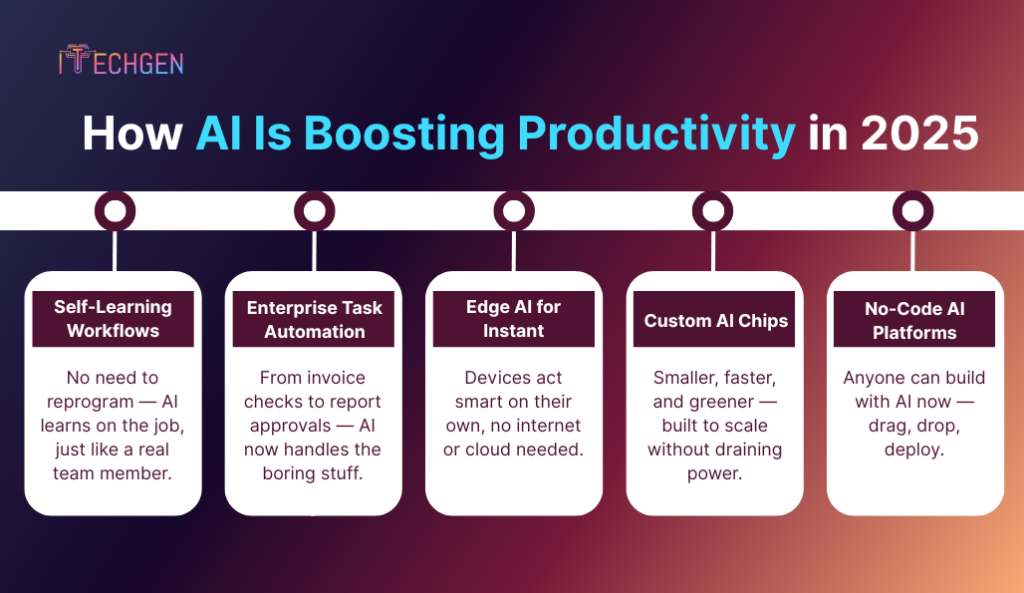
3. AI-Driven Scientific Breakthroughs
AI is no longer just helping with admin work or customer chats — it’s now being used to solve real-world scientific problems. From speeding up drug discovery to predicting climate risks, AI is working with researchers to find answers that used to take years. This is one of the most exciting top AI trends in 2025 because it’s impacting public health, the environment, and future technologies. Scientists are using AI to test ideas faster, reduce lab experiments, and even simulate results before doing real-world trials.
Why It Matters:
- Reduces research time from years to months
- Helps fight diseases, climate change, and other global issues
- Cuts costs for labs, universities, and pharma companies
- Encourages data-backed decision-making in science
- Brings breakthroughs faster to public use (like vaccines or green tech)
Accelerated Drug Discovery
Earlier, it would take years — sometimes a decade — to discover and test a new medicine. But now, AI can study thousands of chemical combinations in days. In 2025, pharma companies are using AI to predict how a drug will work in the body before even making it. This helps cut down lab testing and speeds up approvals. It played a key role during recent outbreaks where vaccines and treatments had to be developed fast.
Climate & Sustainability Modeling
AI is helping scientists track weather changes, rising sea levels, pollution patterns, and crop performance. By processing large sets of satellite and climate data, AI can now warn about floods, droughts, or heatwaves before they happen. This gives governments and farmers a chance to plan better. This trend is already being used globally to protect crops and manage water levels — making it one of the most socially impactful top AI trends this year.
Quantum Computing Integration
Quantum computing is still early-stage, but when paired with AI, it’s starting to show results. Together, they can solve complex problems that regular computers can’t handle — like simulating atoms, decoding DNA, or managing huge energy systems. In 2025, global research labs are testing AI-powered quantum models. These tools are being used to solve physics equations, build better batteries, and improve traffic flow in smart cities. It’s a slow but steady trend that’s pushing the boundaries of what tech can do.
4. Ubiquitous Edge AI
One of the fastest-growing top AI trends in 2025 is Edge AI — where AI runs directly on local devices instead of cloud servers. This means your phone, smartwatch, CCTV, or even a traffic signal can now make smart decisions on the spot, without needing to send data back to a central system. It’s faster, more secure, and ideal for places with weak internet. This trend is especially useful in areas with limited internet access, where real-time responses and local data processing are crucial.
Why It Matters:
- Gives instant response without waiting for cloud processing
- Works even in low or no internet zones
- Keeps data private by processing it locally
- Ideal for smart cities, agriculture, and transport systems
- Reduces cost of cloud storage and bandwidth
Real-Time IoT & Device Intelligence
Edge AI is making devices smarter. A regular home camera, for example, can now detect motion, recognize faces, and send alerts without needing cloud support. In factories, machines use edge AI to track temperature, performance, or errors in real-time — preventing costly damage. These IoT setups are becoming more common in agriculture too, where sensors monitor soil health and water usage on the spot. That’s why this is one of the most practical top AI trends 2025 in rural tech.
Low-Latency Industrial Robotics
In manufacturing or delivery sectors, even a second’s delay can cause errors or accidents. Edge AI allows robots to make decisions quickly — like avoiding obstacles, adjusting grip, or fixing alignment. Since there’s no cloud delay, robots can act in real-time. Warehouses, logistics hubs, and assembly lines are using this to speed up operations safely. Companies around the world are now investing in low-cost edge setups for faster automation without needing heavy cloud infrastructure.
5. Regulation, Ethics, and AI Governance
“Generative AI is a powerful technology that requires careful consideration and regulation to ensure that it is used for the benefit of society.” – Sam Altman
As AI becomes more powerful, there’s a growing need to make sure it’s used responsibly. That’s why one of the most important top AI trends in 2025 is building strong rules, ethical practices, and checks around how AI works. Governments, companies, and tech platforms are now under pressure to ensure that AI doesn’t misuse data, spread misinformation, or harm public trust. It’s not just about what AI can do anymore — it’s also about what it should or shouldn’t do.
Why It Matters:
- Helps protect user data and privacy
- Builds trust in AI-driven platforms
- Encourages responsible AI use in sensitive sectors like finance and healthcare
- Ensures fairness by reducing algorithm bias
- Keeps businesses legally compliant with global laws
Global Compliance Frameworks
Countries around the world are introducing laws to regulate AI — from how it handles personal data to how it makes decisions. There’s growing talk in many countries around digital safety bills and ethical use of automation. Businesses now need to follow international standards like GDPR or upcoming AI-specific acts to stay in the game. Without compliance, companies risk heavy fines, user distrust, or bans in certain regions.
Bias Auditing & XAI Adoption
One of the biggest concerns in AI is bias — where systems treat people unfairly based on gender, caste, age, or other factors. That’s why bias audits and Explainable AI (XAI) are becoming essential. XAI means you can clearly understand why an AI made a certain choice. For example, if a loan gets rejected, the AI should be able to explain the reason. This is especially important in sectors like banking, hiring, or education — where decisions can seriously affect someone’s future.
6. Predictive Cybersecurity AI
With more data moving online and devices staying connected 24/7, cybersecurity has become a serious concern. One of the most critical top AI trends in 2025 is the use of AI to predict and stop cyber threats before they happen. This isn’t like traditional antivirus software that waits for an attack. These new AI systems actively scan patterns, track risks, and flag anything suspicious in real-time — giving teams a head start in preventing damage.
Why It Matters:
- Helps detect threats early and avoid data breaches
- Saves companies from huge financial and legal losses
- Protects user data and online transactions
- Reduces dependency on manual monitoring and response teams
- Works 24/7 to stop both small hacks and large-scale cyber attacks
Proactive Threat Neutralization
AI-powered security tools now go beyond alerts. They actively isolate threats, block suspicious access, and prevent spread — without human input. For example, if a user clicks a phishing link, the system can immediately stop access to the rest of the network. This kind of rapid response is saving banks, hospitals, and even small startups from costly downtimes and data loss. It’s one of the most practical top AI trends 2025 for anyone running a digital business.
Adversarial Attack Mitigation
Some hackers now target AI systems directly — trying to confuse them by feeding false data or weird inputs. This is called an adversarial attack. In 2025, AI tools are learning to detect and defend against these too. They now double-check inputs, flag risky behaviours, and learn from past attacks. This is especially useful in areas like facial recognition or automated driving, where wrong inputs can lead to serious outcomes.
7. Sustainable AI Ecosystems
Sam Altman said that saying things like “please” and “thank you” to ChatGPT uses more energy and costs the company millions, which started a debate on how people talk to AI. But the issue goes beyond just words — AI needs a lot of computing power, which means more electricity, more servers, and higher carbon emissions. That’s why in 2025, one of the top AI trends is not just building smarter or faster models, but building ones that work more responsibly. Companies and researchers are now focusing on making AI systems that consume less power, run on cleaner energy, and leave a smaller environmental footprint. This shift matters, especially as the world tries to balance rapid digital growth with the urgent need to fight climate change.
Why It Matters:
- Reduces energy bills and long-term operational costs
- Helps companies meet global climate and sustainability goals
- Encourages responsible tech growth
- Makes AI development more efficient and scalable
- Attracts eco-conscious investors and partners
Energy-Efficient Model Training
Training large AI models takes massive amounts of electricity — sometimes equal to powering hundreds of homes for days. But now, developers are using smarter ways to train models with fewer resources. By using smaller datasets, optimized code, or energy-efficient chips, AI can now learn faster with less energy. Many organizations and research teams are also adopting these practices to cut infrastructure costs and stay green.
Carbon-Neutral AI Infrastructure
Big tech firms are building data centers powered by renewable energy — like solar or wind. Some are also offsetting their carbon emissions by investing in eco-projects. This trend is slowly catching on in India too, especially in IT parks and cloud services. The idea is simple: build and run AI systems without harming the planet. As clients and governments push for cleaner solutions, carbon-neutral AI setups will become the standard, not the exception.
8. Neuro-Adaptive Interfaces
One of the most futuristic yet fast-growing top AI trends in 2025 is neuro-adaptive interfaces — systems that connect directly with the human brain or understand user emotions in real-time. These technologies allow AI to respond to how you feel, think, or react — without needing a touchscreen or voice commands. It sounds sci-fi, but it’s already being tested in areas like healthcare, gaming, mental wellness, and even workplace productivity tools.
Why It Matters:
- Makes technology more intuitive and human-friendly
- Helps people with disabilities interact with devices using thoughts
- Opens new doors for brain-based learning, therapy, and entertainment
- Allows apps and devices to adjust automatically based on user mood
- Brings AI closer to natural human behaviour
Brain-Computer Interfaces (BCIs)
BCIs let users control digital devices directly with their brain signals. In simple terms, you can move a cursor, type text, or play a game just by thinking — no physical movement needed. These tools are helping people with paralysis or motor issues regain control over basic tasks. Medical researchers are exploring this tech for therapy and rehab. It’s early-stage, but it’s one of the most human-focused top AI trends 2025 out there.
Emotion-Aware AI Systems
AI is now learning to sense your mood by tracking facial expressions, speech tone, or typing speed. So if you’re feeling stressed, the system can adjust visuals or tone to match your mood in real-time. In call centers, AI tools are helping agents understand when a customer is angry or upset — and guide the conversation accordingly. Even educational apps are starting to adjust lesson difficulty based on how engaged the student feels. This makes tech feel more personal and empathetic.
9. Quantum AI and Next-Gen Architectures
As traditional AI models start to reach limitations, there is a growing trend towards strong and fast, generative systems that are able to manage the next upper level of workloads. Increasingly important for 2025, quantum AI and hardware will increasingly enter into the AI and data science landscape. Even as these technologies are not yet commonplace, they are paving the way for the next transformation. AI will soon perform sophisticated calculations and run massive simulations within seconds.
Why It Matters:
- Reduces time needed to process complex tasks
- Supports scientific research, fintech, and enterprise planning
- Enables more energy-efficient and high-speed computing
- Helps AI handle larger datasets and deeper models
- Unlocks new use cases where classical AI falls short
Quantum-Powered AI Models
Quantum AI models work with qubits — allowing them to explore multiple outcomes at once. This is a game-changer for sectors like finance, aerospace, healthcare, and climate science where traditional models take too long. These systems can simulate molecular behavior, calculate risk in seconds, and run massive data comparisons — all without the usual delays. While still developing, this trend is building a strong foundation for what’s expected to power the next decade of AI growth.
Custom AI Chips and Hardware
Modern AI isn’t just about software. It’s also about the hardware that runs it. New AI-specific chips — like Tensor Processing Unit (TPUs) and Neural Processing Unit (NPUs) — are being built to handle deep learning tasks faster and at lower power. These chips are going into phones, servers, and edge devices. By eliminating latency and reducing energy consumption, they facilitate a realistic potential of real-time AI especially with small form factor designs. In 2025, this new technology is a key part of going to scale with AI while increasing performance and sustainability.
Scalable AI Infrastructure
With AI tools becoming heavier, companies are switching to modular and scalable infrastructure. It will potentially combine cloud, edge, and custom hardware in a flexible way so AI may run at will. Whether for training in cloud-based systems or deploying local solutions, organizations will be able to break down the abstraction of architecture to put AI into relatable large productions. Most relative to businesses who want high reliability at any scale, but want to do this without building a big infrastructure.
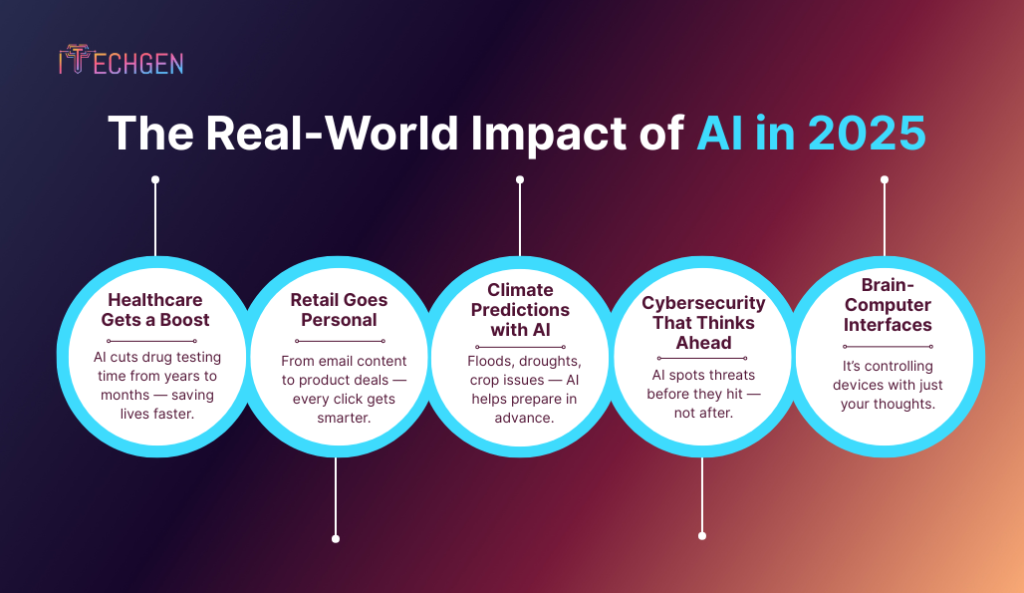
10. Democratization of AI Development
AI is no longer locked behind walls of big budgets or advanced technical degrees. One of the most empowering top AI trends in 2025 is the way AI tools and platforms are becoming accessible to more people — developers, marketers, students, freelancers, and even small business owners. Whether you’re building a chatbot, automating tasks, or analyzing data, you don’t need to be an expert anymore. The entry barrier is dropping, and that’s speeding up innovation across industries.
Why It Matters:
- Gives non-tech users the power to build AI tools
- Cuts dependency on large teams or enterprise-level solutions
- Speeds up testing, building, and launching of AI projects
- Encourages experimentation and faster problem-solving
- Expands the AI talent pool across different backgrounds
No-Code and Low-Code AI Tools
You don’t need to write thousands of lines of code to build with AI anymore. No-code and low-code platforms let users drag, drop, and set up automation using simple interfaces. This means marketing teams can build lead scoring tools, HR teams can filter resumes, and product managers can test AI features — without needing a full-stack developer.
Open-Source AI Frameworks
One of the strongest forces behind this trend is open-source. Platforms like TensorFlow, PyTorch, and Hugging Face have created large libraries, models, and communities that anyone can use for free. Developers can pick up pre-trained models, tweak them for their needs, and get support online. This makes it easier for individuals and small teams to build without starting from scratch.
Community-Driven Innovation
Forums, YouTube channels, online courses, and GitHub projects are fuelling faster learning and collaboration. People are now sharing tools, fixing bugs together, and creating AI apps in public. This collective growth is helping the ecosystem stay fresh and practical. It’s also making sure that real-world problems — not just big business goals — are being solved with AI.
Conclusion
AI in 2025 is no longer just a buzzword — it’s a real force changing how businesses operate, how users interact with technology, and how industries evolve. From creative tools that anyone can use, to self-learning systems that run entire workflows, the top AI trends 2025 this year show how fast the technology is moving. What’s more important now is not just knowing what AI can do, but understanding where it’s heading — and how to adapt early.
These trends aren’t just limited to tech companies. Retail, healthcare, education, logistics — every sector is starting to see the value of smarter systems, faster decisions, and personalized experiences. Whether it’s predicting security threats, cutting energy usage, or building apps that think and learn — the impact is everywhere. And with better hardware, cleaner energy, and easier access to tools, the AI ecosystem is only getting stronger.
The best part? You don’t need to be an expert to benefit. As these technologies become easier to access, more businesses — big or small — can tap into AI to solve real problems. Keeping an eye on these top AI trends 2025 helps you stay ahead, build smarter, and make choices that align with the future of tech. AI is no longer a thing of the future — it’s already a big part of today’s world. It’s already here — and it’s growing fast.

Pankaj Arora (Founder & CEO)
Pankaj Arora is the Founder & CEO of iTechGen, a visionary leader with a deep passion for AI and technology. With extensive industry experience, he shares expert insights through his blogs, helping businesses harness the power of AI to drive innovation and success. Committed to delivering customer-first solutions, Pankaj emphasizes quality and real-world impact in all his endeavors. When not leading iTechGen, he explores emerging technologies and inspires others with his thought leadership. Follow his blogs for actionable strategies to accelerate your digital transformation and business growth.
View More About Pankaj Arora
